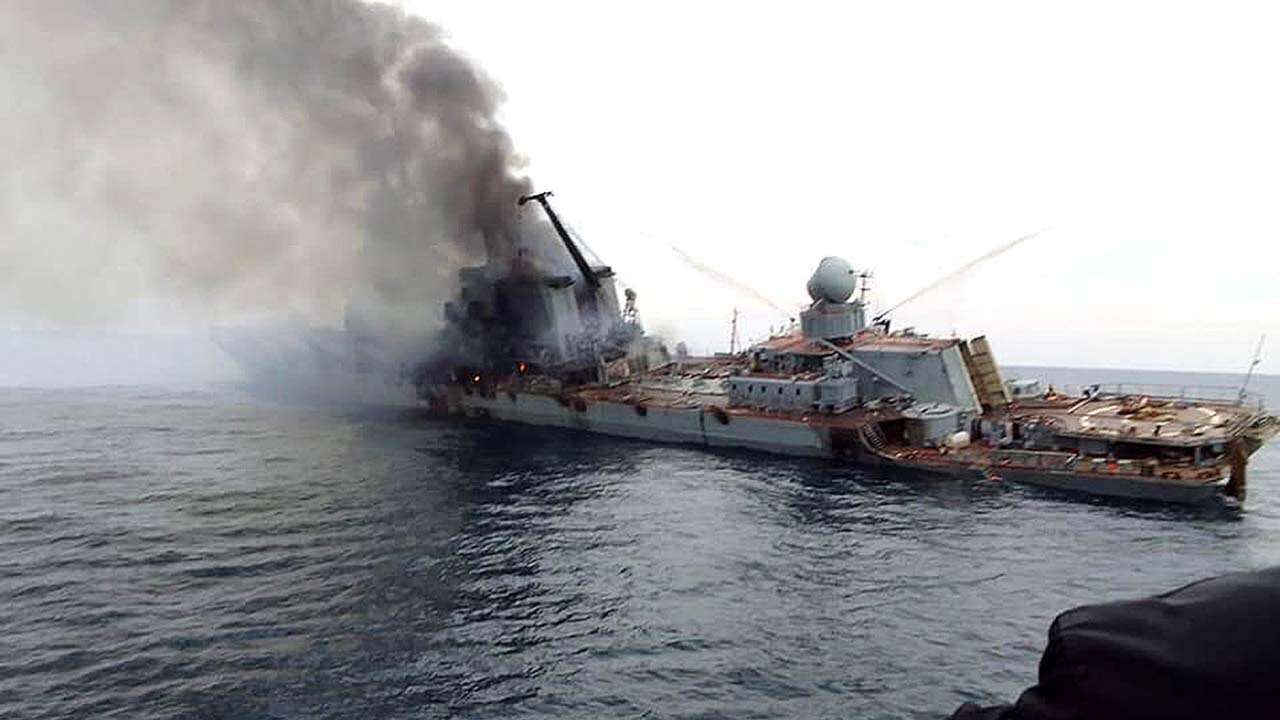The Admiral Makarov frigate of project 11356 could become the new flagship of Russia’s Black Sea Fleet after the guided-missile cruiser Moskva was sunk in mid-April by the Ukrainian Armed Forces.
Chinese Bombers Loaded With ‘Carrier Killer’ YJ-12 Missiles Hold Drills To Keep ‘US Military’ Out Of Taiwan
“Following the loss of Moskva, one of the three project 11356 frigates may become the new flagship of the Russian Black Sea fleet. So far, the Admiral Makarov has been chosen,” reported Russian state news agency TASS, citing a source in Crimean Security Agency.
This development comes after the unexpected loss of the SLAVA-class cruiser Moskva in mid-April when the Ukrainian forces sank it by firing two Neptune anti-ship missiles. Moskva was one of the most powerful warships in the Russian Navy.
Besides being the floating command and control center, Moskva was also the provider of long-range and mobile air defense protection for the entire Black Sea Fleet.
Russia-Ukraine War Leads To Global Food Scarcity But US ‘Arms & Farms’ Sector Emerge ‘Big Winners’
This could be the reason why after the sinking of Moskva, five Russian warships in the northern part of the Black Sea reportedly moved further away from the coast.

Admiral Makarov, A Temporary Wartime Solution
After the loss of Moskva, the Russian Black Sea fleet was expected to choose a new flagship to maintain fleet command and control. However, flagships of the Russian Navy’s fleets are selected from cruisers and the only other two ships of the same class as Moskva, Marshal Ustinov and the Varyag, serve with Russia’s Northern and Pacific fleets, respectively.
Neither of these ships can be brought to replace the Moskva because Turkey, who controls access to the Black Sea via the Bosphorus Strait under the Montreux Convention, has decided not to let the Russian warships enter at a time of war.
Therefore, the Grigorovich-class frigates, such as the Admiral Makarov, are the most suitable candidates for assuming flagship duties temporarily under wartime conditions. The Ukrainian forces had claimed earlier that the Admiral Makarov was also hit by Neptune anti-ship missiles that set it on fire. However, those claims turned out to be inaccurate.

Project 11356 frigate, the Admiral Makarov, was laid down by the Yantar Shipyard on February 29, 2012, and launched on September 2, 2015. The Russian Navy commissioned it on December 25, 2017.
Admiral Makarov is the third ship in project 11356 frigates built by the Yantar Shipyard for the Defense Ministry. The first two project 11356 frigates, Admiral Grigorovich and Admiral Essen, were delivered to the Russian Navy in 2016. All three warships are operational in the Black Sea Fleet.
Project 11356 Frigates
Project 11356 frigates have a displacement of 4000 tons and a speed of 30 knots, with a cruising capacity of 30 days. The frigates incorporate a stealthy hull design developed by the Severnoye Design Bureau. The hull and superstructures are designed to have low radar, acoustic and infrared signatures.

The frigates measure 124.8m in overall length and 15.2m in width and feature a flight deck to carry a Ka-28 or a Ka-31 helicopter.
The Project 11356 frigates can be deployed in anti-surface warfare, anti-submarine warfare and anti-air missions. They are capable of conducting assignments as a single vessel or as part of a task force.
The Club-N missile system fitted onboard the frigate serves as the anti-ship missile. The missiles are launched by an eight-cell 3S-14E under-deck launcher, complemented by a 3R-14N-11356 fire control system and 3C-25E acquisition radar.
As for anti-aircraft defense, the frigate has a Shtil-1 medium-range air defense missile system, Igla man-portable surface-to-air missile system and Kashtan air defense missile/gun system, including up to six fire modules, a command module, storage and reloading system, 64 missiles, and 6,000 rounds of 30mm ammunition.
The Shtil-1 complex is equipped with a 3S90E launcher and 3R90E1 fire control system. It can simultaneously engage up to 12 targets within a range of 3.5km to 32km.
The ASW capability of the frigate is provided by two DTA-53-11356 twin torpedo tubes and an RBU-6000 depth charge rocket launcher firing 90R ASW rockets and RGB-60 depth rocket bombs.

Sergey Shoigu
The main gun is fitted on the forward bow deck, a 100mm A190E gun featuring a 5P-10E fire control system that enables effective tracking and engagement of multiple targets. The А190 naval gun can fire high-explosive (impact fuse) and AA (time fuse) ammunition at 80 rounds per minute for ranges exceeding 20km.
Once the war is over, and the straits are opened to the passage of warships, the Russian Navy may deploy a larger and more capable naval asset to the Black Sea Fleet in terms of command and control capabilities.
Reports suggest Marshal Ustinov, which is the flagship of the Northern Fleet, could be reassigned to the Black Sea Fleet if it is replaced by the Kirov-Class Cruiser Admiral Nakhimov, which is being overhauled at the Sevmash Shipyard.
Earlier this month, H.I. Sutton, an independent journalist focusing on naval warfare, spotted the Admiral Makarov sailing near Sevastopol in the Russian-occupied Crimean Peninsula, together with most of the other ships belonging to the Black Sea Fleet.
Analysts suggest that Kremlin is reluctant to risk these ships after the loss of Moskva and wants them near Crimea, where Russian ships enjoy the protection of shore-based S-400 surface-to-air missile batteries and the Russian Navy’s Su-30 fighter jets.
- Written by Tanmay Kadam/EurAsian Times Desk
- Contact the author at etdesk@eurasiantimes.com
- Follow EurAsian Times on Google News




